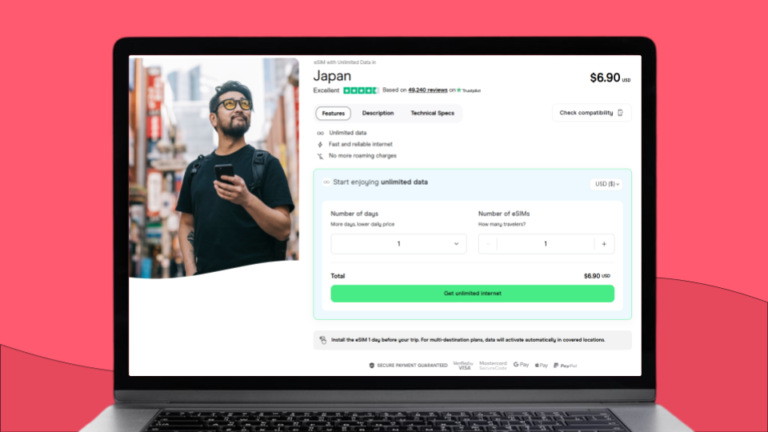eSIM vs. pocket WiFi in Japan: Which one should you choose?
eSIMs are the cheaper and more convenient way to stay connected in Japan, while pocket WiFi offers a solid option for large groups of travelers.
Having steady internet access in Japan is a must. It allows you to find your way through busy streets using map apps, communicate with the locals on a translator app, or call a ride to your hotel whenever you need one.
eSIM cards and pocket WiFi devices are two of the most popular options for staying connected on the go in the Land of the Rising Sun. But which one should you choose? Follow along as we dive into the pros and cons of each option. Hopefully, you’ll your own answer by the end.
What is an eSIM?
An eSIM, or an embedded SIM, is a digital SIM card that allows you to connect to local mobile networks in Japan without using a physical Japan SIM card. Over the last few years, using an eSIM has become the preferred way for millions of travelers worldwide to stay connected. All thanks to the convenience and affordable pricing it offers.
Why do I need an eSIM for Japan?
eSIMs offer a more convenient alternative to physical SIM cards with travel plans. All you need is an eSIM-compatible phone and an eSIM plan to enjoy instant internet access in Japan. Most eSIM providers allow data sharing, so you can turn your phone into a mobile hotspot and connect multiple devices at once if needed.
Having an internet connection upon landing in Japan is crucial, as most signs and banners in the cities are in Japanese, making it easy to get lost without internet. With an eSIM, you’ll easily manage to navigate even the busy streets of Akihabara, or buy tickets for such things as bullet trains without having to deal with queues and language barriers.
There are plenty of eSIMs for Japan to choose from, so you’re sure to find one that suits your needs. For a worry-free travel experience, we’d recommend going with an unlimited plan, such as those offered by Holafly. Such plans give you complete peace of mind, knowing that you don’t need to track your data usage and won’t lose connection at the worst time.
Holafly offers up to 500 MB of data sharing daily and has 24/7 customer support in multiple languages, Japanese included. So if you ever encounter questions or issues with the service, you’ll find a customer support agent ready to help you at all times.
How to get an eSIM in Japan
Since an eSIM is a completely digital product, the process of buying one is super simple. You can buy, set up, and activate your eSIM online in minutes, and the process doesn’t require much tech knowledge at all. Here’s how the process looks step-by-step:
- Go to the Holafly website and choose the plan you need.
- Add the plan to your card and complete the checkout process.
- You’ll receive a QR code in your email immediately after purchase.
- Scan the QR code and follow the prompts to set up your eSIM.
- That’s it. Your eSIM is ready for use.
You can buy your eSIM up to six months before your actual trip to Japan and activate it once you land for immediate internet access.

eSIM pros and cons
Let’s quickly recap the pros and cons of using an eSIM in Japan:
Pros
- Quick and simple setup process
- Immediate delivery
- Affordable pricing
- No additional costs
- 24/7 customer support
- Data sharing to multiple devices
Cons
- Data sharing is limited
- Only works on eSIM-compatible devices
What is pocket WiFi?
Pocket WiFi is exactly what it sounds like. It’s a portable WiFi device that fits into your pocket and allows you to connect multiple devices to the WiFi network it creates. Typically, these devices work with mobile data plans, so just having the device itself isn’t enough for creating a network.
As a result, pocket WiFI rental services are more popular than actually owning your own pocket WiFi device. Rentals deliver a device that’s ready to use and you don’t have to worry about buying separate data plans.
While pocket WiFi providers in Japan aren’t as plentiful as eSIMs, there are still quite a few local and international options to choose from.
Why do I need pocket WiFi for Japan?
The reasons for getting pocket WiFi in Japan are the same as for the eSIM — it keeps you connected and helps you make the most of your experience in the country. Whether you want to post photos of cherry blossoms on the spot or read through iconic manga with the help of a translator, pocket WiFi has got you covered.
If you travel in a group and spread out the costs, pocket WiFi can be cheaper than buying separate eSIMs or a physical SIM card for everyone in the group. But it’ll inevitably be one of the most expensive options when traveling to Japan solo or in a small group.
Since pocket WiFi doesn’t limit data sharing, you can keep multiple devices connected at all times, with most providers allowing 5 or more simultaneous connections. That said, most plans have a limit on daily data usage, so either make sure to get an unlimited data plan or monitor your data usage carefully to avoid running out.

How to get pocket WiFi in Japan
Since using pocket WiFi requires a physical device, the rental process is a bit more complicated than that of buying an eSIM.
- Choose a provider with a Japan pocket WiFi plan that suits your needs.
- Pick a delivery option that works for you.
- Pick up your pocket WiFi device and turn it on.
- Connect to the WiFi network created by your device.
- Make sure it’s fully charged before you go out.
If you go with a Japanese provider, you can get the device delivered to your hotel or the airport. A provider closer to your home country can ship the device to your door before your trip.
When your plan runs out, you have to put the device and all accessories back into a package and send it back out to the company you rented it from. The delivery process can take a few days, so make sure to order it before your trip to Japan.
The price for the plans can range from about $35 to $60 USD or more for a week. On top of that, you have to pay shipping fees for delivery and return. Optionally, you can also buy insurance for the device. If you don’t have insurance and lose or damage the device, expect to pay a fine of up to $300.
Pocket WiFi pros and cons
Let’s take a quick look at the main pros and cons of pocket WiFi in Japan to help you decide whether or not it’s a good option for you.
Pros
- No limits on data sharing
- Allows 5+ simultaneous connections
- Good option for larger groups of travelers
Cons
- Additional costs like delivery and insurance
- Includes a lengthy delivery and return process
- Quite expensive if costs aren’t split in a group
- Additional device to carry around at all times
eSIM vs. pocket WiFi Japan: Which one should you choose?
It should now be clear that both eSIM and pocket WiFi provide reliable internet access in Japan. But to find out which option suits you best, we need to take a look at how the two compare head-to-head.
Price
Pocket WiFi rental ranges from $35 to $60 a week, with a majority of the plans offering limited data. Holafly’s Japan eSIM plan costs $29.90 for a week of unlimited data, with the pricing becoming even more appealing for longer plans.
If you consider the additional costs attached to renting a portable router, such as delivery fees and insurance, you’ll find that, on average, pocket WiFi is several times more expensive than using an eSIM.
Purchase and activation process
Buying and setting up an eSIM only takes a few minutes. You can also fill out a pocket WiFi rental form in a similar amount of time, but you’ll have to wait several days for the pocket WiFi device to be delivered to you.
Both are simple to start using. The eSIM activation process only requires you to follow simple prompts, while pocket WiFi devices typically come ready to use and only need to be turned on.
Convenience
Since eSIM technology is embedded into your phone, it doesn’t add any inconvenience at all. You’ll be able to use mobile data on your phone just as you would at home, the only difference being that you’re connected to a local mobile network in Japan.
Pocket WiFi adds one more device to carry with you at all times. You also have to remember to charge it at the end of every day. Otherwise, it’ll run out of battery, and you’ll be left without an internet connection. Keep in mind that Japan uses type A and type B plugs, so you’ll likely need an adapter to charge your devices.
Connection speeds
Many pocket WiFi devices are limited to 4G connection speeds, while eSIMs can reach up to 5G speeds as long as your device supports 5G and the network has 5G coverage in your area. Japan has a vast 5G network, especially in major cities such as Tokyo, Osaka, Hiroshima, or Yokohama, so you’ll definitely feel the difference.
Therefore, if you’re looking for fast internet speeds, choose an eSIM or filter pocket WiFi providers carefully to find one that offers devices capable of 5G connection speeds.

eSIM vs. pocket WiFi in Japan: Overview
Now that we’re done with the details of this eSIM vs. pocket WiFi comparison, let’s quickly run through the key points.
| eSIM for Japan | Pocket WiFi for Japan | |
| Price | $29.90/week for unlimited data | $35+ week for limited data |
| Additional costs | No | Yes |
| Immediate delivery | Yes | No |
| Delivery costs | No | Yes |
| Fee in case of loss or damage | No | Yes |
| Flexible plans and rates | Yes | No |
It’s pretty clear that using an eSIM in Japan is both cheaper and more convenient than pocket WiFi. The only good reason to use the latter is if you’re traveling in a big group and the data sharing limits on your eSIM don’t cover the needs of your co-travelers.
To have the ultimate mobile internet experience, consider getting an eSIM from Holafly. All Holafly plans include unlimited data as well as 24/7 customer support and dedicated apps that make the service super simple to use. Keep your Google Maps and Google Translator open throughout your stay in the Land of the Setting Sun without fear of losing connection.
Still undecided and want the best of both worlds? Holafly Connect is a monthly eSIM subscription that gives you all of the pocket WiFi benefits and more. For $64.90, you’ll get unlimited data and unlimited hotspot in 170+ global destinations. No hidden fees, no clunky devices, and peace of mind under one eSIM plan.





 Language
Language 


















 No results found
No results found





